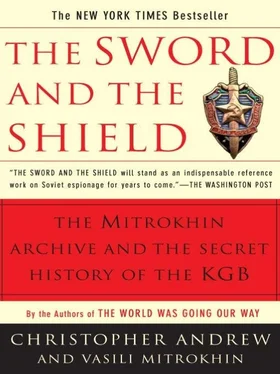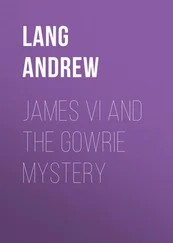On November 15, 1957 the 55-year-old “Rudolf Abel” was sentenced to thirty years in jail. His American lawyer, James Donovan, was struck by “Abel’s” “uncanny calm” as he listened to what was, in effect, a life sentence: “This cool professional’s self-control was just too much for me.” 64“Abel’s” wife, Ilya, who had last seen her husband when he returned on leave to Moscow in the summer of 1955, made less attempt to disguise her feelings. She wrote bitterly to the Centre that it was not simply a question of waiting for twenty-five or thirty years but “I do not know if my husband will ever return.” For the past seven years she had worked as a harpist in a circus orchestra; however, when she criticized the KGB after her husband was jailed, she was made redundant on the pretext that the orchestra no longer needed a harpist. The Centre rejected Ilya “Abel’s” pleas for help in finding another job, but granted her a pension of 51 roubles a month. 65
At Atlanta Penitentiary, in Georgia, where “Rudolf Abel” had been sent to serve his sentence, he became friends with two other convicted Soviet spies. He played chess with Morton Sobell, whose wife had failed to receive the 5,000 dollars embezzled by Hayhanen. 66“Abel” also received a number of small favors from Kurt Ponger, an Austrian-born American in the penitentiary’s dental section who had been sentenced in 1953 to a term of five to fifteen years’ imprisonment for conspiracy to commit espionage while serving in the US army in Austria. Ponger’s file in the KGB archives reveals that he had been a Soviet agent since 1936, but that after his arrest the Centre had wrongly concluded that he was a double agent whose arrest had been deliberately staged by the Americans in order to discredit the Soviet Union in Austrian public opinion. “Abel” had no doubt that Ponger was a genuine Soviet agent and later tried to persuade the KGB to give Ponger financial assistance after he was freed in September 1962. 67
“Abel” served only just over four years of his sentence. On February 10, 1962 he was exchanged on the Glienicker Bridge, which linked West Berlin with Potsdam, for the shot-down American U-2 pilot Gary Powers. 68The exchange was treated by the KGB as a major operation, codenamed LYUTENTSIA, coordinated by Vladimir Trofimovich Burdin, the former resident in Ottawa. An undercover KGB group was stationed in West Berlin to watch for signs of American military activity in the area of the bridge. On the bridge itself, hidden in the offices of the East German Customs Service, was a KGB armed operational group. Close at hand, but also out of view from the Western side of the bridge, was another armed group which had accompanied Powers from Potsdam for the exchange. At the Soviet checkpoint, a specially trained officer from the 105th Regiment was put in command of a detail of submachine gunners. The East Germans provided a reserve unit of twenty men armed with submachine guns and grenades. 69
The Centre congratulated itself on the fact that its absurdly large, concealed military presence had gone almost unobserved. 70“Abel’s” lawyer was more impressed by the fact that the American guard who accompanied his client on to the bridge was “one of the largest men I have ever seen. He must have been six feet seven inches tall and weighed perhaps three hundred pounds.” 71After the exchange of “Abel” for Powers, the Glienicker Bridge became famous during the Cold War as the “Bridge of Spies.” The KGB file on operation LYUTENTSIA records that its total nonmilitary cost (food, train tickets, hotel bills, various items for “Abel” and his wife and daughter, and a celebration dinner) came to 5,388 marks 90 pfennigs. Walter Ulbricht, the East German leader, did not share the Centre’s satisfaction at the success of the operation. He complained to the Soviet ambassador, Pervukhin, on February 15 that his government had not been adequately informed and that the failure to include East German police among Powers’s escort showed lack of respect for the sovereignty of the German Democratic Republic. Ulbricht followed his verbal protest with a diplomatic note citing other Soviet slights. 72
In the United States, “Abel’s” paintings and prints became collectors’ items. The Attorney-General, Robert Kennedy, asked the Soviet embassy to find out whether “Abel” would be willing to give the US government a portrait of his brother, President Kennedy, which he had painted in Atlanta Penitentiary, and allow it to be hung in the White House. The Centre suspected a plot. The proposal to display “Abel’s” portrait in the White House was, it believed, a provocation, though it was not certain what exactly it was intended to provoke. Robert Kennedy’s request was turned down. 73
“Abel” received an unpublicized hero’s welcome on his return to Moscow, being received in turn by Vladimir Yefimovich Semichastny, chairman of the KGB, Aleksandr Mikhailovich Sakharovsky, head of the KGB First Chief (Foreign Intelligence) Directorate, and General Pyotr Ivashutin, head of the GRU. 74At Semichastny’s prompting, “Abel” wrote to Khrushchev to thank him personally for the supposed part he had taken in securing his release: “…I am especially touched by the fact that, amidst the great variety of your Party and governmental concerns, you found the time to think about me as well.”
Though it suited the Centre, for the sake of its own reputation in the Party hierarchy, to portray “Abel’s” mission to the United States as an operational triumph by a dedicated Chekist, brought to a premature conclusion only by an act of treachery for which he bore no responsibility, it was well aware that in reality he had achieved nothing of real significance. He had been arrested in 1957 only because he had disobeyed instructions to leave the country after Hayhanen had failed to return to Moscow. 75
The Centre took advantage of the fact that “Abel” was portrayed in the American media as a master spy of heroic stature. That impression was strengthened by the sympathetic portrayal of him in Strangers on a Bridge, an account by his lawyer of his trial, imprisonment and exchange for Powers published in 1964. Donovan made clear that he “admired Rudolf as an individual,” and quoted Allen Dulles, Director of Central Intelligence from 1953 to 1961, as telling him, “I wish we had three or four just like him in Moscow right now…” He ended his book by printing a letter “Abel” had sent him from Moscow, enclosing two rare, sixteenth-century, vellum-bound Latin editions of Commentaries on the Justinian Code. “Please accept them,” “Abel” wrote, “as a mark of my gratitude for all that you have done for me.” 76
All this was music to the Centre’s ears. 77The myth of the master spy Rudolf Abel replaced the pedestrian reality of Fisher’s illegal residency. The inconvenient lack of heroic exploits to celebrate was glossed over by the assurance that, though there were many of them, they remained too secret to celebrate in public. 78The real “Willie” Fisher, however, became increasingly disillusioned. After his return to Moscow, he was given a chair in a corner of the FCD Illegals Directorate but was denied even a desk of his own. When a friend asked him what he did, he replied disconsolately, “I’m a museum exhibit.” 79
ELEVEN
THE MAIN ADVERSARY
Part 2: Walk-ins and Legal Residencies in the Early Cold War
The KGB’s chief successes against the Main Adversary during the presidencies of Dwight D. Eisenhower (1953-61) and John F. Kennedy (1961-3) derived not from its grand strategy for new illegal residencies, which collapsed for several years after FISHER’s arrest, but from a series of walk-ins. The most important was probably a CIA “principal agent” in West Berlin and Germany, Alexsandr (“Sasha”) Grigoryevich Kopatzky, alias “Koischwitz” (successively codenamed ERWIN, HERBERT and RICHARD), who had offered himself for recruitment by Soviet intelligence in 1949. 1Trained by the KGB in secret writing and microphotography, he was paid a total of 40,000 West German and 2,117 East German marks during the 1950s, as well as being rewarded for his success with several gold watches. 2
Читать дальше











